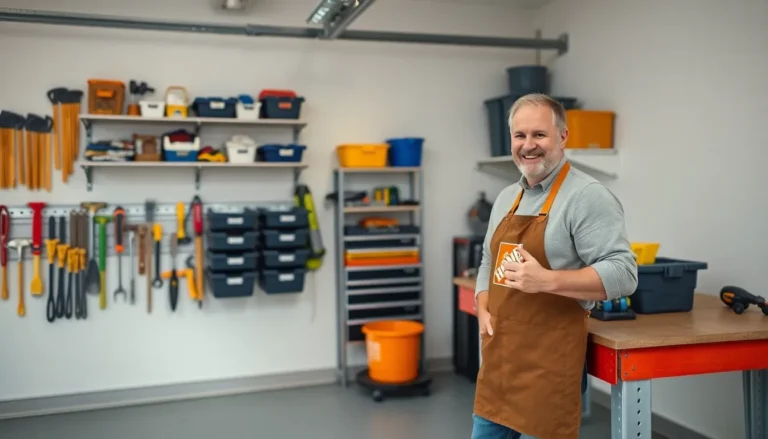In the chaotic world of remote work, the home office desk often becomes a battleground of clutter. It’s where the coffee mugs stack up like trophies and important documents play hide and seek. A disorganized desk can drain productivity faster than a Monday morning meeting. But fear not—transforming that chaotic space into a haven of efficiency doesn’t require a degree in interior design or a weekend marathon of organizational YouTube videos.
Table of Contents
ToggleImportance of Home Office Desk Organization
Effective desk organization significantly enhances productivity levels. Clutter on a workspace leads to distractions that impede focus and efficiency. A streamlined environment enables easier access to necessary tools and documents. Reduced visual noise fosters clarity, allowing individuals to concentrate on tasks.
Studies show organized workspaces can increase productivity by up to 20%. This statistic highlights the tangible benefits of an orderly desk. When items are categorized and stored appropriately, less time is wasted searching for materials.
Additionally, a well-structured desk promotes a positive work environment. It creates a sense of professionalism, even in a home setting. Stress reduction is another advantage, as an organized space brings peace of mind during busy periods.
Time management also improves with proper organization. Scheduling tasks becomes simpler when the workspace is conducive to productivity. Simple strategies, such as using organizers and decluttering regularly, can yield significant results.
Organizing the home office desk isn’t just about aesthetics. It directly correlates with efficiency and overall work satisfaction. By prioritizing desk organization, individuals cultivate a space that reflects their professionalism and supports their daily functions.
Key Elements of Effective Desk Organization
Effective desk organization revolves around creating a functional workspace that enhances productivity. Various components play a crucial role in achieving this goal.
Choosing the Right Desk
Selecting the appropriate desk sets the foundation for an organized workspace. Desks with adjustable features promote comfort and adaptability. Dimensions matter; ensuring the desk fits the room allows for adequate movement. Drawers or shelves contribute to efficient storage, keeping frequently used items close at hand. Overall, the right desk creates a space conducive to focus and efficiency.
Essential Organizational Tools
Incorporating essential organizational tools streamlines the workspace. Drawer organizers maintain order by separating office supplies, making them easy to find. Document trays prevent clutter by providing designated spots for important papers. Cable management solutions minimize tangling, promoting a clean look. Using wall-mounted shelves or pegboards maximizes vertical space, showcasing inspiration while keeping surfaces clear. Each tool contributes to an organized, efficient desk environment.
Tips for Organizing Your Home Office Desk
Effective desk organization enhances productivity and focus. Implementing a few strategic practices can lead to significant improvements in workspace efficiency.
Decluttering Your Workspace
Start by removing unnecessary items from your desk. Keep only essential tools and materials within arm’s reach, ensuring easier access during work. Establish a routine for regular decluttering, aiming for weekly or biweekly cleanouts. Designate specific spaces for items to prevent clutter from accumulating again. Discard items that are no longer useful, donating reusable materials whenever possible.
Creating a Functional Layout
Establishing a functional layout increases efficiency. Position frequently used items, like your computer and notebooks, within easy reach while leaving enough space for movement. Arrange cables discreetly to minimize distractions and avoid tangles. Consider the flow of work; ensure the setup supports task efficiency, whether that involves writing, typing, or participating in virtual meetings. Utilize vertical space effectively by placing shelves or filing systems above the desk to free up surface area.
Implementing Storage Solutions
Storage solutions play a vital role in maintaining an organized desk. Use drawer organizers to categorize and compartmentalize supplies like pens, paper, and sticky notes. Explore vertical file holders for easy access to important documents, reducing desktop clutter. Wall-mounted shelves can store binders or reference materials, keeping them off the desk while still within reach. Invest in decorative storage boxes that add aesthetic appeal while holding miscellaneous items, ensuring every part of the workspace remains orderly and accessible.
Maintaining an Organized Desk
An organized desk is essential for maintaining productivity. Daily routines play a crucial role in keeping a workspace tidy and efficient.
Establishing Daily Routines
Start each day with a quick desk tidy-up. Dedicate five minutes to rearranging items and clearing clutter. Prioritize high-use tools, placing them within arm’s reach. Storing documents in an organized manner simplifies access during tasks. Consider implementing a consistent time for decluttering. Making this part of the daily routine fosters habit formation.
Regularly Assessing Your Setup
Assessing the desk setup regularly helps identify areas for improvement. Schedule weekly evaluations to check the functionality of the layout. Analyze the placement of storage solutions and the efficiency of organization tools. Adjust items based on changing needs and preferences. Taking the time to adjust ensures the workspace remains optimal. Tracking progress over time enhances productivity and satisfaction.
An organized home office desk is more than just a neat appearance; it’s a catalyst for increased productivity and reduced stress. By implementing simple strategies for decluttering and utilizing effective storage solutions, anyone can create a workspace that enhances focus and efficiency.
Regular maintenance and thoughtful organization can transform a chaotic environment into a streamlined haven for work. As individuals prioritize their workspace setup, they’ll likely notice significant improvements in their daily productivity and overall work satisfaction. Embracing these practices not only fosters a more professional atmosphere but also cultivates positive work habits that can lead to long-term success.







